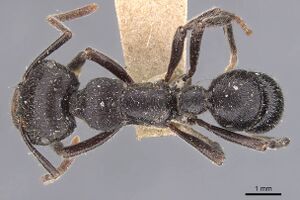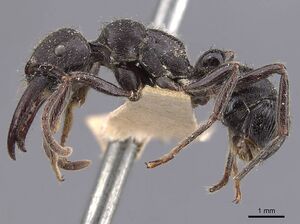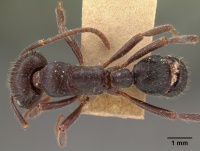Gnamptogenys schmitti
| Gnamptogenys schmitti | |
|---|---|

| |
| Scientific classification | |
| Kingdom: | Animalia |
| Phylum: | Arthropoda |
| Class: | Insecta |
| Order: | Hymenoptera |
| Family: | Formicidae |
| Subfamily: | Ectatomminae |
| Tribe: | Ectatommini |
| Genus: | Gnamptogenys |
| Species: | G. schmitti |
| Binomial name | |
| Gnamptogenys schmitti (Forel, 1901) | |
| Synonyms | |
| |
A predator of millipedes whose range has shrunken considerably this century due to massive deforestation on Hispaniola (Lattke 1995).
Identification
A member of the concinna species group. Very broad head, in frontal view, and striking elongate mandibles without denticles; striae on anterior nodal face transverse, slightly effaced laterally; striae on metanotum and propodeum transverse; gastrics ternum II smooth and shining. This species represents an extreme in the development of falcate mandibles within the genus (Brown 1958: 215), but probably represents a development independent of the banksi subgroup species. (Lattke 1995)
Keys including this Species
Distribution
Latitudinal Distribution Pattern
Latitudinal Range: 18.53° to -15.69305556°.
| North Temperate |
North Subtropical |
Tropical | South Subtropical |
South Temperate |
- Source: AntMaps
Distribution based on Regional Taxon Lists
Neotropical Region: Dominican Republic, Greater Antilles.
Distribution based on AntMaps
Distribution based on AntWeb specimens
Check data from AntWeb
Countries Occupied
| Number of countries occupied by this species based on AntWiki Regional Taxon Lists. In general, fewer countries occupied indicates a narrower range, while more countries indicates a more widespread species. |

|
Estimated Abundance
| Relative abundance based on number of AntMaps records per species (this species within the purple bar). Fewer records (to the left) indicates a less abundant/encountered species while more records (to the right) indicates more abundant/encountered species. |

|
Biology
From Wheeler and Mann (1914): At Petionville a single worker was captured in a humid spot near a little stream. At Diquini, in a shaded place, also near a stream, two colonies were found, one under a stone and one by following up a worker that was out foraging in the late afternoon. This worker was carrying a Polydesmid Diplopod thrown over its body in such a manner that the ant was entirely concealed beneath its burden. The opening of the nest was circular and about one quarter of an inch in diameter, and led into a tunnel beneath a stone where some of the workers were gathered, though most of them, together with the larvre and pupae, were in chambers deeper in the earth, some six or seven inches below the surface. Scattered about in the nest were numerous fragments and several entire examples of a species of Polydesmid and of another Diplopod allied to our northern Julus. This fact, together with the behavior of the worker described above, indicates that E. schmitti feeds chiefly or entirely on Myriopods. The workers move slowly and deliberately like those of Ectatomma tuberculatum and Ectatomma ruidum. They seem to be very timid and secrete themselves when the nest is excavated. Probably they are crepuscular. The males are attracted to lights, all the specimens having been taken at night by Mr. J. B. Terres on the verandah of his house at Diquini.
Castes
Worker
Images from AntWeb
   
| |
| Syntype of Gnamptogenys schmitti. Worker. Specimen code casent0907193. Photographer Will Ericson, uploaded by California Academy of Sciences. | Owned by MHNG, Geneva, Switzerland. |
Nomenclature
The following information is derived from Barry Bolton's Online Catalogue of the Ants of the World.
- schmitti. Emeryella schmitti Forel, 1901e: 334 (w.) HAITI.
- Type-material: syntype workers (number not stated, “numerous”), 4 syntype males.
- Type-locality: Haiti: Diquini, and Petionville, 1912-13 (W.M. Mann).
- Type-depository: MCZC.
- Wheeler, W.M. & Mann, 1914: 9 (m.l.); Wheeler, G.C. & Wheeler, J. 1952a: 127 (l.).
- Combination in Gnamptogenys: Brown, 1958g: 229; Camacho, Franco, Branstetter, et al. 2022: 11.
- Status as species: Wheeler, W.M. 1905b: 120; Emery, 1911d: 46; Wheeler, W.M. & Mann, 1914: 8 (redescription); Brown, 1958g: 229; Kempf, 1972a: 114; Bolton, 1995b: 210; Lattke, 1995: 182; Lattke, et al. 2007: 261 (in key); Lubertazzi, 2019: 117; Camacho, et al. 2020: 459 (in key); Camacho, Franco, Branstetter, et al. 2022: 11.
- Senior synonym of minor: Brown, 1958g: 229, 330; Kempf, 1972a: 114; Bolton, 1995b: 210.
- Distribution: Haiti.
- minor. Emeryella schmitti subsp. minor Wheeler, W.M. 1936b: 195 (w.) HAITI.
- Type-material: 4 syntype workers.
- Type-locality: Haiti: Massif de la Hotte, NE foothills, 3000 ft, 1934 (P.J. Darlington).
- Type-depository: MCZC.
- [Unresolved junior secondary homonym of Ectatomma bicolor var. minor Forel, 1900d: 317 (Bolton, 1995b: 209).]
- Junior synonym of schmitti: Brown, 1958g: 229, 330; Kempf, 1972a: 114; Bolton, 1995b: 209.
Unless otherwise noted the text for the remainder of this section is reported from the publication that includes the original description.
Description
Worker
From Wheeler and Mann (1914): Length 7-9 mm.
Head large, subrectangular, broader than long, broader in front than behind, with rather straight sides and feebly excised posterior border. Eyes moderately large, at the middle of the sides of the head. Mandibles longer than the head, inserted far apart at its anterior corners, sublinear and curved, somewhat broader at the base, obliquely truncated at the tip, with a large, blunt, triangular tooth at the basal third and a few indistinct, widely separated denticles on the most distal portion of the internal border. Clypeus very short, its anterior border in the middle straight, excised on the sides at the insertions of the mandibles, its median surface rather flat. Frontal carina very short, about as far apart as each is from the lateral border of the head. Frontal area distinct, triangular. Antennal scapes slightly curved, their tips extending a short distance beyond the posterior corners of the head; funicular joints 1-4 distinctly longer than broad, the second longest; joints 5-10 scarcely longer than broad, terminal joint. as long as the two preceding taken together. Thorax short and robust, much narrower than the head, broadest through the pronotum which has rounded, convex sides and dorsum. Promesonotal suture deep. Meso- and epinotum not separated by a suture, together but little longer than the pronotum including the neck. The base of the epinotum, which is unarmed, straight above in profile and passing into the concave or flattened declivity through a rounded angle. Petiole longer than broad, narrower in front than behind, about as long as high, in profile rounded and convex above, with a more abrupt posterior declivity to the node; ventrally with a small tooth at its anterior border. Gaster more than twice as broad as the petiole, short, its first segment campanulate, as broad as long, with a strong tooth on its anterior ventral border; second segment somewhat longer than broad, very convex dorsally, remaining segments small, telescoped into the second segment and directed forward. Sting small. Legs rather long.
Somewhat shining; mandibles coarsely and sparsely punctate; head and pronotum sharply longitudinally rugose; meso- and epinotum and petiolar node transversely rugose; first gastric segment in front with arcuate rugae which enclose behind a space that is longitudinally rugose; second segment with much coarser and sharper rugae converging at the anterior and posterior borders of the segment. Antennal scapes and legs covered with small piligerous punctures.
Hairs short, coarse, grayish, erect on the body, shorter and more reclinate on the appendages.
Black, with a slight reddish tinge, which is more pronounced on the mandibles, antennae, tarsi and articulations of the legs; terminal segments of gaster paler red or brownish.
Male
From Wheeler and Mann (1914): Length 6-7 mm.
Head, including the mandibles, a little longer than broad, very convex and rounded behind, with large, convex eyes and ocelli. Clypeus moderately convex, with broadly and feebly excised anterior border. Frontal area distinct, triangular; frontal carina very small. Mandibles small, triangular, pointed, with a few distinct teeth on the base of their apical border. Antennae very long; funicular joints 2-13 slender, cylindrical and subequal, first joint somewhat longer than broad, distinctly shorter than the third joint. Thorax rather short and robust, mesonotum with pronounced Mayrian furrows; epinotum sloping, rounded, unarmed, without distinct base or declivity. Petiole nearly twice as long as broad, scarcely narrower in front than behind, above with a very low, rounded node and below feebly concave in profile, with a minute tooth at its anterior end. Gaster similar to that of the worker, but the first and second segments more slender and the terminal segments more developed and not turned forward. First segment with a median longitudinal ridge on the dorsal side. Genitalia very small. Hypopygium minute, bluntly triangular. Cerci present. Legs long, and slender. Wings rather narrow.
Body shining. Mandibles, head. and posterior portion of mesonotum punctate and finely, longitudinally striate. Surface of epinotum, petiole and first gastric segment uneven but scarcely rugose, the epinotum with coarse, scattered punctures. Second and following segments smooth and shining and like the legs, covered with minute piJigerous punctures. Hairs yellow, erect and abundant, both on the body and appendages.
Uniformly red; antenna beyond the second joint fuscous; wings infuscated, with blackish veins and stigma.
Type Material
Lattke (1995) examined the type series in the Museum of Comparative Zoology.
References
- Brown, W. L., Jr. 1958g. Contributions toward a reclassification of the Formicidae. II. Tribe Ectatommini (Hymenoptera). Bulletin of the Museum of Comparative Zoology 118: 173-362 (page 229, Combination in Gnamptogenys and senior synonym of minor)
- Forel, A. 1901j. Variétés myrmécologiques. Ann. Soc. Entomol. Belg. 45: 334-382 (page 334, worker described)
- Lubertazzi, D. 2019. The ants of Hispaniola. Bulletin of the Museum of Comparative Zoology, 162(2), 59-210 (doi:10.3099/mcz-43.1).
- Wheeler, G. C.; Wheeler, J. 1952a. The ant larvae of the subfamily Ponerinae - Part I. Am. Midl. Nat. 48: 111-144 (page 127, larva described)
- Wheeler, W. M.; Mann, W. M. 1914. The ants of Haiti. Bull. Am. Mus. Nat. Hist. 33: 1-61 (page 9, male, larva described)
References based on Global Ant Biodiversity Informatics
- Brown W. L., Jr. 1958. Contributions toward a reclassification of the Formicidae. II. Tribe Ectatommini (Hymenoptera). Bulletin of the Museum of Comparative Zoology 118: 173-362.
- Emery C. 1911. Hymenoptera. Fam. Formicidae. Subfam. Ponerinae. Genera Insectorum 118: 1-125.
- Forel A. 1901. Variétés myrmécologiques. Annales de la Société Entomologique de Belgique 45: 334-382.
- Kempf, W.W. 1972. Catalago abreviado das formigas da regiao Neotropical (Hym. Formicidae) Studia Entomologica 15(1-4).
- Lattke J. E. 1995. Revision of the ant genus Gnamptogenys in the New World (Hymenoptera: Formicidae). Journal of Hymenoptera Research 4: 137-193
- Perez-Gelabert D. E. 2008. Arthropods of Hispaniola (Dominican Republic and Haiti): A checklist and bibliography. Zootaxa 1831:1-530.
- Wheeler W. M. 1905. The ants of the Bahamas, with a list of the known West Indian species. Bulletin of the American Museum of Natural History 21: 79-135.
- Wheeler W. M., and W. M. Mann. 1914. The ants of Haiti. Bulletin of the American Museum of Natural History 33: 1-61.

